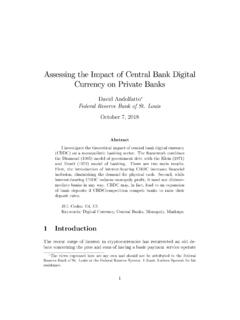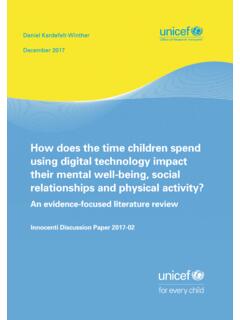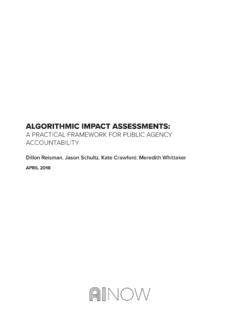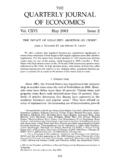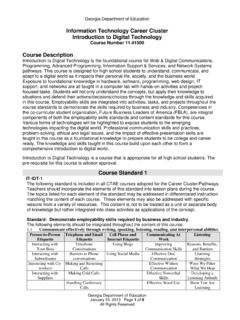Transcription of TEACHER GUIDANCE - Georgia Standards
1 TEACHER GUIDANCE For teaching the Georgia Standards of Excellence (GSE) Grade S even Georgia Department of Education July 22, 2015 Page 2 of 51 Introduction The purpose of this document is to provide strategies and understanding for the Georgia Standards of Excellence (GSE). About Grades Six through Eight The grades six through eight Standards define what students should understand and be able to do by the end of each grade. Instruction in grades 6-8 addresses students increasing maturity and the growing sophistication of their abilities, culminating in the development by the end of grade 8 of students who are ready to succeed in high school. Students should be able to comprehend more challenging books and articles, basing all of their analyses, inferences, and claims on explicit and relevant evidence from the texts.
2 Students will expand on their ability to identify central ideas by identifying how those themes are shaped and conveyed by particular details. Their analysis of basic literary elements will extend to identifying connections and complexities within narratives and how individual elements weave together to advance plot and reveal character. The evaluation of the impact of language on tone and meaning will begin to include more sophisticated concepts such as analogy and allusion, subtleties in point of view such as dramatic irony, and a more sophisticated appreciation for connotative diction. These skills will be incorporated into the students own narrative and expository writing. Students will become increasingly adept at understanding an author s biases, the use of complex rhetorical devices including logical fallacies, and tailoring their own prose for maximum influence.
3 While continuing with a variety of literary non-fiction, students in grades 6-8 will begin to tackle more technical informational texts as well. Literary selections will include foundational materials from mythology, cultural histories, and religious traditions. Georgia Department of Education July 22, 2015 Page 3 of 51 GSE TEACHER GUIDANCE : Skills, concepts, strategies, tasks, and suggested key terms Georgia Department of Education July 22, 2015 Page 4 of 51 Seventh Grade GSE Reading Literary (RL) ELAGSE7RL1: Cite several pieces of textual evidence to support analysis of what the text says explicitly as well as inferences drawn from the text. Skills/Concepts for Students: Practice careful and attentive reading of both assigned texts and independent text choices Read a wide variety of texts, including a variety of styles, genres, literary periods, authors, perspectives, and subjects Distinguish facts that support a specific claim from facts that are irrelevant Annotate texts in order to gather text evidence for claims ( , reading for a purpose ) Practice reading texts within the prescribed time limit for grade-level expectations ( , completing a 300 page book within the number of days outlined by the assignment)
4 Instructional Strategies for Teachers Provide explicit instruction and scaffolding as necessary for the skills and concepts students should acquire for RL1 Provide frequent opportunities to examine individual literary and rhetorical terms to uncover the author s meaning Require students to take effective notes and allow them to use these notes in assessments on occasion in order to support their engagement in the process Assign reading at a level of rigor (including complexity and length) so that students continue to develop text endurance Provide students with opportunities to find evidence for claims that are explicit, inferred, content-related, and literary concept-related ( , find evidence that Robert is not an honest person [inferred/content-related], find evidence that Ann is class president [explicit/content-related], find evidence that the author is intentionally creating a suspenseful mood [inferred/literary concept-related], find evidence of the author s use of sensory detail [explicit/literary concept-related], etc.)
5 Use strategies such as RACE (Restate, Answer, Cite, Explain) to help students organize their writings Examine genre characteristics Sample Performance-based/ Standards -based Task(s): Because standard RL1 is concerned with identifying multiple pieces of evidence to support a claim or inference about the text, tasks supporting this standard should require students to understand the relationship between a claim and effective su pport for that claim, and to then identify several pieces of evidence. Using a literary text, provide students with a claim to be su pported ( , Cite 3 pieces of evidence from the text that prove that Anne is not romantically interested in Robert ). Usi ng the definitions in Bulle t 6 above under Strategies for Teachers, provide students with several types of evidence to find.
6 Allow students to try this activity alone, in pairs, and in groups. Students should create well-organized notes detailing their findings. (Tier II) Vocabulary for Teaching and Learning: Diction Syntax Tone Mood Figurative Language Imagery Sensory Details Genre Characterization Setting Plot Explicit Implicit Inferred Relevant Irrelevant Evidence Claim Extraneous Georgia Department of Education July 22, 2015 Page 5 of 51 Seventh Grade GSE Reading Literary (RL) ELAGSE7RL2: Determine a theme and/or central idea of a text and analyze its development over the course of the text; provide an objective summary of the text. Skills/Concepts for Students: Understand the difference between theme and central idea; some texts are concrete in nature and deal literally with a topic, such as World War II, while other texts tell a story in order to connect with or make a point about a larger, more universal human experience such as friendship or betrayal Make predictions about developing themes within your class notes, citing evidence that influences an evolving opinion Incorporate multiple literary elements into your determination of theme (tone, mood, imagery, organizational structure, narrative voice, etc.)
7 Practice summarizing a text using facts only, without relating your opinion about the text (this is harder than you might think!) Understand theme is an author s universal statement on a topic (message, moral, lesson) Instructional Strategies for Teachers: Provide explicit instruction and scaffolding as necessary for the skills and concepts students should acquire for RL2 (see above) Discuss the development of theme at consistent intervals throughout the exploration of a text; question students about themes that they see developing and what evidence they can provide to support their claim Compare and contrast themes from various literary eras, historical periods, and genres; observe how themes occur within various time periods and locations ( Compare themes from folktales from Africa to those from the Middle East.)
8 Allow students to examine individual elements as they contribute to theme as well as how the theme is developed as a whole ( , characterization) Require students to summarize without bias frequently; note when opinion begins to creep into the summary and use student models to discuss Sample Performance-based/ Standards -based Task(s): Using visual texts such as movies, commercials, or photographs can be a constructive way to begin a discussion of theme and central idea. Using movies with which most students are familiar, have students attempt to identify the theme and central idea of the film ( , the theme of The Wizard of Oz may be identified as People should appreciate what they have, or Be careful what you wish for. ). Using chart paper or a Smart Board, list evidence the students are able to provide to support their claims about the nature of the theme.
9 Allow students to discuss and debate as they shape their best possible answer as a class. Provide students with a biased source and have them create an unbiased summary. Use this opportunity to point out instances when a biased summary appears. This activity can be extended by determining the theme or central idea of a photograph or painting (students will be surprised to find how many literary elements are present in visual text: tone, mood, sensory details, connotative images or colors, characters, setting, etc.). An example of this is Pixar s short animated film For the Birds, which can be found on YouTube. (Tier II) Vocabulary for Teaching and Learning: Theme Biased/Unbiased Objective Subjective Diction Tone Mood Characterization Organizational Structure Plot Structure Setting Exposition Rising Action Climax Falling Action Georgia Department of Education July 22, 2015 Page 6 of 51 Seventh Grade GSE Reading Literary (RL) ELAGSE7RL3: Analyze how particular elements of a story or drama interact ( , how settings shape the characters or plot).
10 Skills/Concepts for Students: Identify and analyze elements of plot: exposition, rising action, climax, falling action, resolution Examine plot structure, understanding the way in which conflict drives the action in a story and how the chapters or sections of a text are organized and compiled Identify and analyze the elements of characterization (a character s thoughts, words, actions, appearance, experiences, etc.) Understand the concept of narrative voice (point of view, first, second, or third person/omniscience, subjectivity, reliable/unreliable narrator, etc.) Recognize the importance of setting, seeking to understand how the setting can dynamically affect the action or the characters in a story Be able to identify subplots and parallel plots, understanding their relationship to the central plot and theme Instructional Strategies for Teachers: Provide explicit instruction and scaffolding as necessary for the skills and concepts students should acquire for RL3, specifically, including plot, character, setting, and language Provide texts illustrating a number of narrative structures (a variety of plot strategies such as frame narrative, flashback, foreshadowing) and voices ( first, second, or third person, omniscience, subjectivity, etc.)










